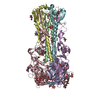+ Open data
Open data
- Basic information
Basic information
| Entry | Database: EMDB / ID: EMD-10697 | |||||||||
|---|---|---|---|---|---|---|---|---|---|---|
| Title | Ectodomain of X-31 Haemagglutinin at pH 5 (State I) | |||||||||
 Map data Map data | ||||||||||
 Sample Sample |
| |||||||||
 Keywords Keywords | Haemagglutinin / Hemagglutinin / Fusion protein / VIRAL PROTEIN | |||||||||
| Function / homology |  Function and homology information Function and homology informationviral budding from plasma membrane / clathrin-dependent endocytosis of virus by host cell / host cell surface receptor binding / fusion of virus membrane with host plasma membrane / fusion of virus membrane with host endosome membrane / viral envelope / virion attachment to host cell / host cell plasma membrane / virion membrane / membrane Similarity search - Function | |||||||||
| Biological species |   unidentified influenza virus unidentified influenza virus | |||||||||
| Method | single particle reconstruction / cryo EM / Resolution: 3.0 Å | |||||||||
 Authors Authors | Benton DJ / Rosenthal PB | |||||||||
| Funding support |  United Kingdom, 2 items United Kingdom, 2 items
| |||||||||
 Citation Citation |  Journal: Nature / Year: 2020 Journal: Nature / Year: 2020Title: Structural transitions in influenza haemagglutinin at membrane fusion pH. Authors: Donald J Benton / Steven J Gamblin / Peter B Rosenthal / John J Skehel /  Abstract: Infection by enveloped viruses involves fusion of their lipid envelopes with cellular membranes to release the viral genome into cells. For HIV, Ebola, influenza and numerous other viruses, envelope ...Infection by enveloped viruses involves fusion of their lipid envelopes with cellular membranes to release the viral genome into cells. For HIV, Ebola, influenza and numerous other viruses, envelope glycoproteins bind the infecting virion to cell-surface receptors and mediate membrane fusion. In the case of influenza, the receptor-binding glycoprotein is the haemagglutinin (HA), and following receptor-mediated uptake of the bound virus by endocytosis, it is the HA that mediates fusion of the virus envelope with the membrane of the endosome. Each subunit of the trimeric HA consists of two disulfide-linked polypeptides, HA1 and HA2. The larger, virus-membrane-distal, HA1 mediates receptor binding; the smaller, membrane-proximal, HA2 anchors HA in the envelope and contains the fusion peptide, a region that is directly involved in membrane interaction. The low pH of endosomes activates fusion by facilitating irreversible conformational changes in the glycoprotein. The structures of the initial HA at neutral pH and the final HA at fusion pH have been investigated by electron microscopy and X-ray crystallography. Here, to further study the process of fusion, we incubate HA for different times at pH 5.0 and directly image structural changes using single-particle cryo-electron microscopy. We describe three distinct, previously undescribed forms of HA, most notably a 150 Å-long triple-helical coil of HA2, which may bridge between the viral and endosomal membranes. Comparison of these structures reveals concerted conformational rearrangements through which the HA mediates membrane fusion. | |||||||||
| History |
|
- Structure visualization
Structure visualization
| Movie |
 Movie viewer Movie viewer |
|---|---|
| Structure viewer | EM map:  SurfView SurfView Molmil Molmil Jmol/JSmol Jmol/JSmol |
| Supplemental images |
- Downloads & links
Downloads & links
-EMDB archive
| Map data |  emd_10697.map.gz emd_10697.map.gz | 2.1 MB |  EMDB map data format EMDB map data format | |
|---|---|---|---|---|
| Header (meta data) |  emd-10697-v30.xml emd-10697-v30.xml emd-10697.xml emd-10697.xml | 17.2 KB 17.2 KB | Display Display |  EMDB header EMDB header |
| FSC (resolution estimation) |  emd_10697_fsc.xml emd_10697_fsc.xml | 14.2 KB | Display |  FSC data file FSC data file |
| Images |  emd_10697.png emd_10697.png | 126.6 KB | ||
| Masks |  emd_10697_msk_1.map emd_10697_msk_1.map | 244.1 MB |  Mask map Mask map | |
| Filedesc metadata |  emd-10697.cif.gz emd-10697.cif.gz | 5.8 KB | ||
| Others |  emd_10697_half_map_1.map.gz emd_10697_half_map_1.map.gz emd_10697_half_map_2.map.gz emd_10697_half_map_2.map.gz | 226.4 MB 226.4 MB | ||
| Archive directory |  http://ftp.pdbj.org/pub/emdb/structures/EMD-10697 http://ftp.pdbj.org/pub/emdb/structures/EMD-10697 ftp://ftp.pdbj.org/pub/emdb/structures/EMD-10697 ftp://ftp.pdbj.org/pub/emdb/structures/EMD-10697 | HTTPS FTP |
-Related structure data
| Related structure data |  6y5hMC  6y5gC  6y5iC  6y5jC  6y5kC  6y5lC M: atomic model generated by this map C: citing same article ( |
|---|---|
| Similar structure data |
- Links
Links
| EMDB pages |  EMDB (EBI/PDBe) / EMDB (EBI/PDBe) /  EMDataResource EMDataResource |
|---|---|
| Related items in Molecule of the Month |
- Map
Map
| File |  Download / File: emd_10697.map.gz / Format: CCP4 / Size: 244.1 MB / Type: IMAGE STORED AS FLOATING POINT NUMBER (4 BYTES) Download / File: emd_10697.map.gz / Format: CCP4 / Size: 244.1 MB / Type: IMAGE STORED AS FLOATING POINT NUMBER (4 BYTES) | ||||||||||||||||||||||||||||||||||||||||||||||||||||||||||||
|---|---|---|---|---|---|---|---|---|---|---|---|---|---|---|---|---|---|---|---|---|---|---|---|---|---|---|---|---|---|---|---|---|---|---|---|---|---|---|---|---|---|---|---|---|---|---|---|---|---|---|---|---|---|---|---|---|---|---|---|---|---|
| Projections & slices | Image control
Images are generated by Spider. | ||||||||||||||||||||||||||||||||||||||||||||||||||||||||||||
| Voxel size | X=Y=Z: 1.09 Å | ||||||||||||||||||||||||||||||||||||||||||||||||||||||||||||
| Density |
| ||||||||||||||||||||||||||||||||||||||||||||||||||||||||||||
| Symmetry | Space group: 1 | ||||||||||||||||||||||||||||||||||||||||||||||||||||||||||||
| Details | EMDB XML:
CCP4 map header:
| ||||||||||||||||||||||||||||||||||||||||||||||||||||||||||||
-Supplemental data
-Mask #1
| File |  emd_10697_msk_1.map emd_10697_msk_1.map | ||||||||||||
|---|---|---|---|---|---|---|---|---|---|---|---|---|---|
| Projections & Slices |
| ||||||||||||
| Density Histograms |
-Half map: #1
| File | emd_10697_half_map_1.map | ||||||||||||
|---|---|---|---|---|---|---|---|---|---|---|---|---|---|
| Projections & Slices |
| ||||||||||||
| Density Histograms |
-Half map: #2
| File | emd_10697_half_map_2.map | ||||||||||||
|---|---|---|---|---|---|---|---|---|---|---|---|---|---|
| Projections & Slices |
| ||||||||||||
| Density Histograms |
- Sample components
Sample components
-Entire : X-31 Influenza Haemagglutinin
| Entire | Name: X-31 Influenza Haemagglutinin |
|---|---|
| Components |
|
-Supramolecule #1: X-31 Influenza Haemagglutinin
| Supramolecule | Name: X-31 Influenza Haemagglutinin / type: complex / ID: 1 / Parent: 0 / Macromolecule list: #1-#2 |
|---|---|
| Source (natural) | Organism:   unidentified influenza virus unidentified influenza virus |
| Molecular weight | Theoretical: 164 KDa |
-Macromolecule #1: X-31 Influenza Haemagglutinin HA1
| Macromolecule | Name: X-31 Influenza Haemagglutinin HA1 / type: protein_or_peptide / ID: 1 / Number of copies: 3 / Enantiomer: LEVO |
|---|---|
| Source (natural) | Organism:   unidentified influenza virus unidentified influenza virus |
| Molecular weight | Theoretical: 34.967324 KDa |
| Recombinant expression | Organism:  |
| Sequence | String: NSTATLCLGH HAVPNGTLVK TITDDQIEVT NATELVQSSS TGKICNNPHR ILDGIDCTLI DALLGDPHCD VFQNETWDLF VERSKAFSN CYPYDVPDYA SLRSLVASSG TLEFITEGFT WTGVTQNGGS NACKRGPGSG FFSRLNWLTK SGSTYPVLNV T MPNNDNFD ...String: NSTATLCLGH HAVPNGTLVK TITDDQIEVT NATELVQSSS TGKICNNPHR ILDGIDCTLI DALLGDPHCD VFQNETWDLF VERSKAFSN CYPYDVPDYA SLRSLVASSG TLEFITEGFT WTGVTQNGGS NACKRGPGSG FFSRLNWLTK SGSTYPVLNV T MPNNDNFD KLYIWGIHHP STNQEQTSLY VQASGRVTVS TRRSQQTIIP NIGSRPWVRG LSSRISIYWT IVKPGDVLVI NS NGNLIAP RGYFKMRTGK SSIMRSDAPI DTCISECITP NGSIPNDKPF QNVNKITYGA CPKYVKQNTL KLATGMRNVP E UniProtKB: Hemagglutinin |
-Macromolecule #2: X-31 Influenza Haemagglutinin HA2
| Macromolecule | Name: X-31 Influenza Haemagglutinin HA2 / type: protein_or_peptide / ID: 2 / Number of copies: 3 / Enantiomer: LEVO |
|---|---|
| Source (natural) | Organism:   unidentified influenza virus unidentified influenza virus |
| Molecular weight | Theoretical: 19.912959 KDa |
| Recombinant expression | Organism:  |
| Sequence | String: GLFGAIAGFI ENGWEGMIDG WYGFRHQNSE GTGQAADLKS TQAAIDQING KLNRVIEKTN EKFHQIEKEF SEVEGRIQDL EKYVEDTKI DLWSYNAELL VALENQHTID LTDSEMNKLF EKTRRQLREN AEEMGNGCFK IYHKCDNACI ESIRNGTYDH D VYRDEALN NRFQ UniProtKB: Hemagglutinin |
-Macromolecule #5: 2-acetamido-2-deoxy-beta-D-glucopyranose
| Macromolecule | Name: 2-acetamido-2-deoxy-beta-D-glucopyranose / type: ligand / ID: 5 / Number of copies: 6 / Formula: NAG |
|---|---|
| Molecular weight | Theoretical: 221.208 Da |
| Chemical component information |  ChemComp-NAG: |
-Experimental details
-Structure determination
| Method | cryo EM |
|---|---|
 Processing Processing | single particle reconstruction |
| Aggregation state | particle |
- Sample preparation
Sample preparation
| Concentration | 1.25 mg/mL |
|---|---|
| Buffer | pH: 5 |
| Grid | Model: Quantifoil R2/2 / Material: COPPER / Mesh: 300 / Pretreatment - Type: GLOW DISCHARGE / Pretreatment - Time: 30 sec. |
| Vitrification | Cryogen name: ETHANE / Chamber humidity: 100 % / Chamber temperature: 277 K / Instrument: FEI VITROBOT MARK III |
- Electron microscopy
Electron microscopy
| Microscope | FEI TITAN KRIOS |
|---|---|
| Image recording | Film or detector model: FEI FALCON III (4k x 4k) / Detector mode: COUNTING / Average exposure time: 60.0 sec. / Average electron dose: 33.9 e/Å2 |
| Electron beam | Acceleration voltage: 300 kV / Electron source:  FIELD EMISSION GUN FIELD EMISSION GUN |
| Electron optics | Illumination mode: FLOOD BEAM / Imaging mode: BRIGHT FIELD / Cs: 2.7 mm |
| Sample stage | Specimen holder model: FEI TITAN KRIOS AUTOGRID HOLDER / Cooling holder cryogen: NITROGEN |
| Experimental equipment |  Model: Titan Krios / Image courtesy: FEI Company |
 Movie
Movie Controller
Controller










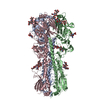


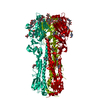
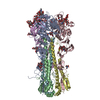
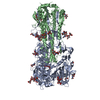
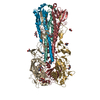
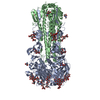
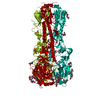
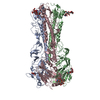

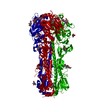
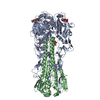
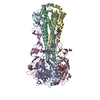
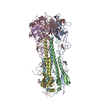
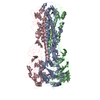

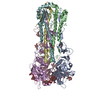
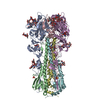
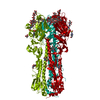






 Z (Sec.)
Z (Sec.) Y (Row.)
Y (Row.) X (Col.)
X (Col.)














































